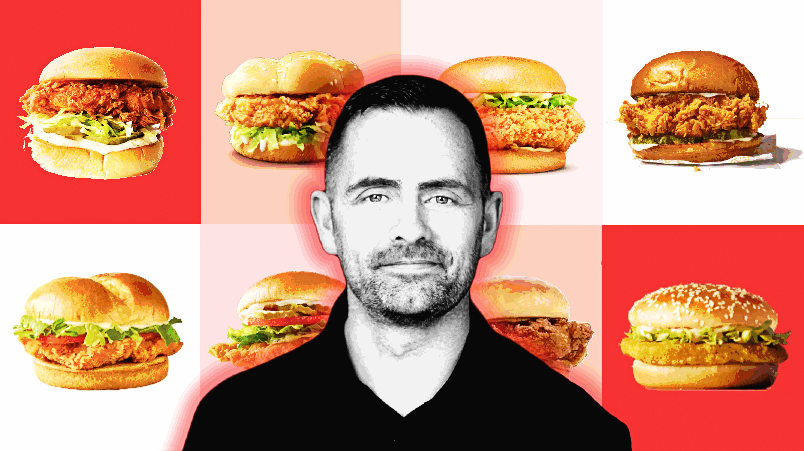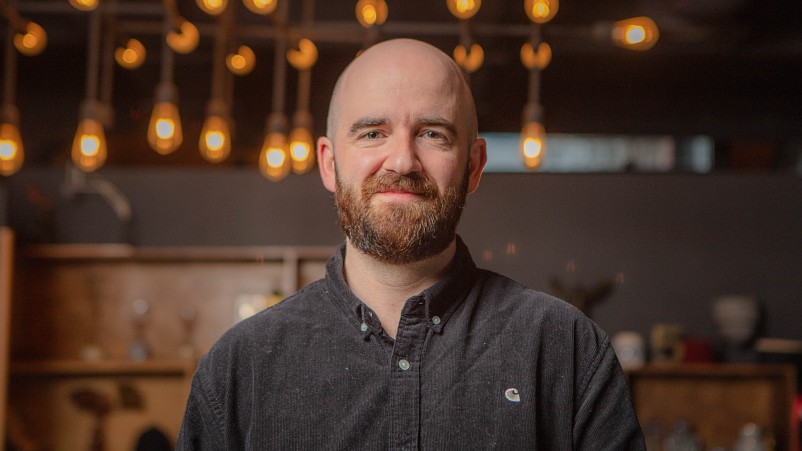Wingers and losers: When the next great chicken war arrives, KFC is betting experience management will help it rule the roost

KFC is the world's fastest growing fast food franchise in a market so hyper competitive that when the famous chicken sandwich wars broke out in the US between 2019 and 2022, it created a nation wide chicken shortage. To maintain its place at the top of the pecking order, the brand is betting big on experience management and scaling up a UK proof of concept project internationally. Mi3 caught up with KFC's global COO Rob Swain in the US, who shared some nuggets about the program – if not the entire secret recipe.
What you need to know
- KFC is on a roll (or maybe a burger). It's the world's fastest growing fast food franchise and with 27,000 restaurants and more than $US30bn in revenues any new technology adoption requires the disciplines and capabilities to manage at scale.
- 98 per cent of its staff report to a restaurant general manager which makes the front line customer experience critical to success.
- A UK-based proof of concept of the Qualtrics experience management platform confirmed what is was doing well and badly, but also reveals the impacts across those dimensions were much greater than they anticipated.
- The project is now moving into the scale up phase, equipping KFC's front line staff with the tools they will need when the next chicken war erupts.
- Yes, chicken war. The Great Chicken Sandwich war in the US between 2019 and 2022 was so fierce it led to national shortages in chicken stocks and surging prices.
- It also exposed the important of genuine end-to-end data and system orchestration, and served as a reminder that customer experience management goes far beyond customer-facing systems.
- Supply chain integration is critical and the current generation of experience management platforms still need to extend into ERP systems to deliver genuine end to end integration.
- To manage the process of scaling up its experience management solution, KFC is focussing on strict governance, a clear definition of challenges, and robust alignment with tech partner Qualtrics on strategy and structure.
The reality is that 98 per cent of all our people around the world actually work for a restaurant general manager. So the frontline is the business.
KFC, the fastest growing fast food franchise in the world, with over 27,000 outlets worldwide and global revenues in excess of $30bn is in the process of scaling up a global experience management platform to help its front line teams make better decisions, faster. The project is designed to help its store owners – who manage more than 98 per cent of its staff – to better understand which aspects of customer experience are bad, and dragging on revenue, and which parts are good, and can be amplified to deliver a greater share of wallet.
"We're in the service industry, and I think sometimes people think we’re just selling buckets of chicken every single day, but we're actually selling experiences," says KCF COO Rob Swain. "When you think about the idea of the frontline, the reality is that 98 per cent of all our people around the world actually work for a restaurant general manager. So the frontline is the business."
That's why the company avoids even the idea of a ‘head office’. "It doesn't exist," says Swain. "It’s a restaurant support centre."
KFC therefore wants to empower every single restaurant manager, per Swain, because the business lives or dies on their success or failure.
"What that means is 27,000 restaurant managers winning versus the competition – and beating the competition one postcode, one zip code, at a time. I'm really passionate about making sure that our restaurant teams have the right tools, the right insights, so that they can deliver the best experiences."
Chicken channels
It's important to understand the context of the fast food industry to appreciate why the new experience management program is necessary, Swain tells Mi3. “The number of channels that we operate has fundamentally moved over the last several years.”
When he started at the brand 14 years ago as an area coach, there was drive thru, takeaway and a front counter. “Now, depending on which country you're in, there’s also click and collect, kiosks, table service and quick pickup."
And those channels – and data sources keep expanding. Collins Food Group for example, which runs over 240 KFC stores in Australia, began trialling drone deliveries direct to homes and work places in 2022, something of a build on its Uber Eats deliveries.
All of this expansion in customer choice has led to an explosion unstructured data that can be mined for insightful nuggets, but creates greater channel complexity: KFC quite literally now has millions of conversations and data in which to hunt for signals.
“We’re in this really fascinating position where we want to understand what's happening for our guests at every point during that journey. We want to understand what's happening when someone's been using the kiosk in the UX after one minute. We want to know what's happening for someone that's been through the drive thru three times in the same month," says Swain. "And we also want to understand what's happening for our team members at every point during their journey."
Proof points
KFC began a proof of concept (POC) experience management program in the UK to help it move beyond the kind of traditional solicited and survey-based guest listening program beloved by quick service restaurants – and seemingly every brand you ever interact with – around the world.
The goal of the POC was to prove out the case for an approach to build an experience management program with an omnichannel view that was able to ingest data from as many different sources as possible – and see what the data throws up versus the traditional system, giving teams better insight on what they are doing well, and what needs to be improved.
“We're trying to make sure the restaurant teams are clear about how they can delight guests," says Swain. "We want the restaurant teams to focus on execution.”
It was also key that the information delivered to restaurant teams be specific and usable. “It's no longer good enough for any CX vendor to give a restaurant manager insight that say 'You have a problem on accuracy', because the manager is going to straight away say ‘specifically, what do I do?’
“This is where the partnership with Qualtrics has came up. We needed a partner and technology platform to help us say, after looking at the data, ‘You have a challenge with your drive thru on a Friday between five and six that’s related to accuracy because with the Mighty Bucket for One, you've missed my sauce or the dip out of the order."
“That’s an actionable insight for a restaurant team.”
At the same time, KFC also wanted to prove how its cross-function customer teams could better support the restaurant support team (what the rest of us would call Head Office) in areas like menu complexity.
“Ultimately the goal is to bring together all the data together in essentially one dashboard that very quickly provides a regional general manager or a restaurant team with a view on what is working well, where they should focusing. Then to help them prioritise very quickly what they should be focusing their team on."
So what did the POC prove?
Swain said the POC demonstrated that while KFC was already aware of the reasons it was both disappointing and delighting guests, the extent of the impact across both those measures was very different to what the brand imagined.
“From there, it was then a fairly straightforward case for us to scale.”
Ultimately the goal is to bring together all the data in essentially one dashboard that very quickly provides a regional general manager or a restaurant team with a view on what is working well, where they should focusing, and then helping them prioritise very quickly what they should be focusing their team on.
The immediate problem
KFC’s pilot project and subsequent plans to scale are consistent with the behaviour many brands implementing customer voice programs, according to VP and Principal Analyst at Constellation Research, Liz Miller, another attendee at the conference in Salt Lake City, which Mi3 attended.
“A lot of customers out there know they have an immediate problem to solve. Maybe that problem is that frontline employees don't have a history of what's happening with a new product.”
Miller, as it turns out is both a KFC and customer experience aficionado, and she recounts the experience of her most recent trip to India where she discovered KFC’s Chizza, a cheesy chicken pizza that , according to the advertising promise, is all chicken and no crust (though you could argue it's actually at least half cheese).
“For KFC to introduce the Chizza for instance, if you don't know what the market's reaction to that is, how does your general manager in a franchise store know ‘Oh, my God, this is going to be really hot. We need to make sure that we have all the ingredients so our team can make this.”
Which brings us to the limitations of many experience management platforms. While they can equip store managers on the customer edge with powerful tools and insights to respond to their site-specific problems, and business managers back at the core with very rich and actionable data, at a systemic level, companies still need to orchestrate across the enterprise.
Qualtrics for instance has very strong connections into marketing tech and CRM platforms, but ERP integrations are still over the horizon, according to company execs Mi3 spoke with.
Until companies can seamlessly connect all the elements of the supply chain, the potential the operational disconnection remains strong.
And chickens, it seems, are an excellent way to illustrate the problem.
So Popeyes goes on a run with a media campaign saying we're the best. And what happens to Popeye's stores, they get flooded with people who want to try America’s best chicken sandwich.
The Great Chicken Sandwich Wars
As Miller describes it, the United States had supply chain problems long before Covid made them fashionable.
“During the Great Chicken Sandwich Wars," she avers with appropriate seriousness, “Everyone came out with their own chicken sandwich. Chick-fil-A was saying theirs was the best. Popeyes was saying theirs was the best.”
The two brands famously got into a tweet war which, as the New York Times dryly observed, transfixed the internet for a week and a half. Feathers flew.
While the social zingers may have been short-lived, the online tête-à-tête ignited an extraordinary burst of industry competitiveness. Over the next two years more than 20 US fast food brands – including KFC – fattened up their menus with fried chicken sandwiches. The run on chickens was enough to make a Silicon Valley Bank risk manager blush. Chicken stocks evaporated and priced spiked.
Things did not end well.
Per Miller, “So Popeyes goes on a run with a media campaign saying we're the best. And what happens to Popeyes stores? They get flooded with people who want to try America’s best chicken sandwich.” Great, but franchisees had no idea what was coming down the pipe. “There was no centralised system to let them know hey, you actually need to double your order this week and here's why,” says Miller.
Focus
Miller, and KFC’s Swain both told Mi3 that something like an experience management program is much more likely to succeed when businesses know what problem they are trying to solve.
With the POC now behind him, Swain has turned his mind to the challenges of scale, though he suggests the team is undaunted. “We've got a lot of experience of rolling things out globally. We're in 150 countries.”
He believes a focus in three areas in particular — strict governance, a clear definition of challenges, and alignment between KFC and its supplier on strategy and structure — will be critical as it rolls out the new experience management tool around the world.
“Those three thing, we're in the thick of that right now. I would advise anyone going through something like this — number one — be very clear about the governance of the project.”
That means understanding and communicating clearly what the program is going to do – and not going to do – in various markets. It’s also important to understand where the potential challenges will arise. For a global roll out, language is an obvious and important consideration, he says.
“What is going to get translated and what isn't. Qualtrics supports 24 languages. But when we say 24 languages, does that mean for example, we're going to translate everything into 24 languages? Or do we only want the UX that we use day-to-day be translated? Getting into the detail is pretty important.”
Strategy-structure
The last issue he flags is ensuring that both KFC and its technology partner are aligned around the strategy and the structure.
One of the immutable laws of project management is that if you are not seeing red lights flashing everywhere in governance meetings then people are probably lying to you. We asked Swain about the red lights he had seen so far.
“It's too early in our in our process. That's the honest answer today, I think we signed a global contract late last year, and the implementation will take anywhere from between 18 months and two years."
But he knows they are coming.
“I think it will be around things like resource allocation, and language translation will be somewhere in the mix."
For now, it's the start of the mother of all chicken runs.



